Table of Contents
Say the power goes out, and you need a reliable, pleasant, and long-lasting candle without an overwhelming fragrance. Burn a beeswax candle. It will burn longer and more cleanly than any other candle. In addition, the light is bright: it’s the same spectrum as natural sunlight.
If you’re meditating and you like burning candles with a subtle aroma that won’t trigger your allergy and asthma symptoms, distract you with fragrance, and burn significantly longer than any other candles, burning beeswax candles is the way to go. This soot-free light source with a honey aroma may help you find peace. If not, beeswax candles are still pretty cool.
Candlelight is relaxing. The gentle light and flicker of the flame create a soothing ambiance that focuses your mind and elevates your mood. A candlelight dinner is romantic, and a candlelight bath…heavenly. A great candle can ensure a quality experience. Candles can make a moment extra special.
When you are trying to create a special mellow moment with candlelight, and you want to use the best possible candles, candles that will last a long time, burn cleanly with very little smoke and produce the best light spectrum, you should choose beeswax candles.
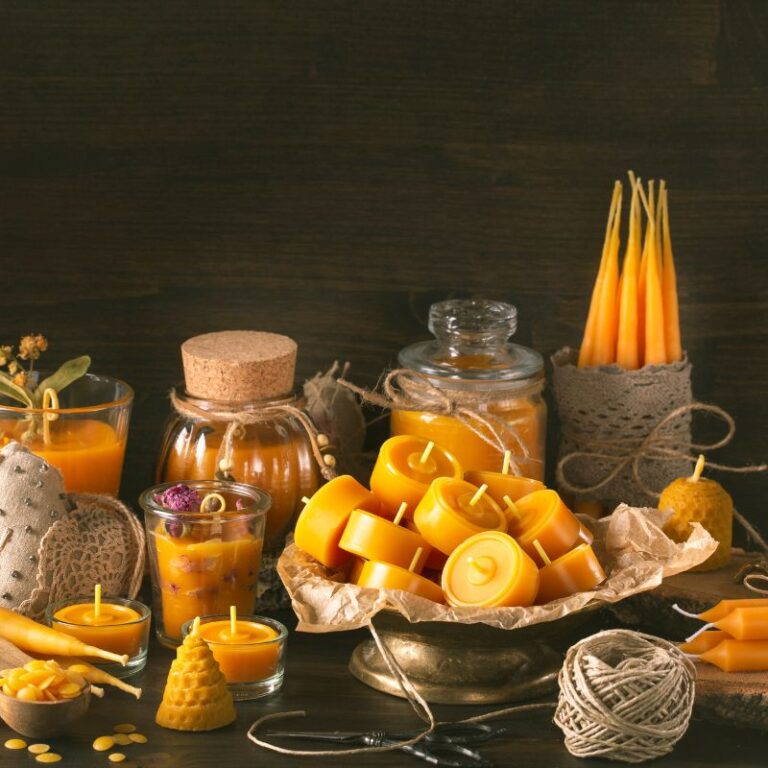
Beeswax Is A Natural Product
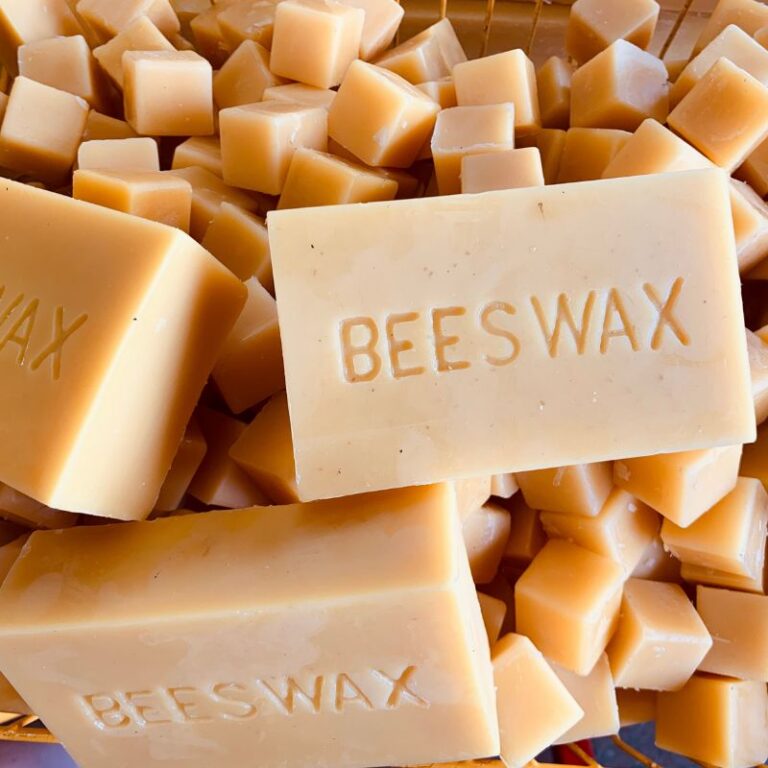
100% Pure beeswax candles are all-natural, non-toxic, and made from beeswax produced by worker honeybees. Worker honeybees create and build the comb with the wax that comes from 8 special glands in their abdomens, and when beekeepers harvest honey or retire old comb, they clean and render the wax to prepare it for use in candles and many other products. Microscopic bits of pollen and nectar will remain in the beeswax.
The embedded bits of pollen and nectar give beeswax candles a natural, sweet but subtle honey aroma when they burn. Beeswax candles are often hand-crafted; candle making is a craft, so you will probably be supporting a small business when you buy a beeswax candle.
Beware of Fake Beeswax Candles
Beeswax is expensive, and you get what you pay for. When you buy beeswax candles, look for the 100% pure beeswax description on the label. If you think about it, beeswax should be more expensive. The bees, beekeepers, and candlemakers all worked hard to produce it. Here’s a test: If you bend a pure beeswax taper or another thin candle, it will bend without breaking. It is dense. Soy and paraffin candles are brittle, and they will break.
A candle can legally be labeled a beeswax candle if it is at least 51% beeswax. Often, to lower prices, candle makers will blend beeswax with 49% paraffin or other substances and then dye the candles to look like beeswax. Some beeswax is better than no beeswax, but 100% pure beeswax candles will be the best candles you can buy and are worth every penny.
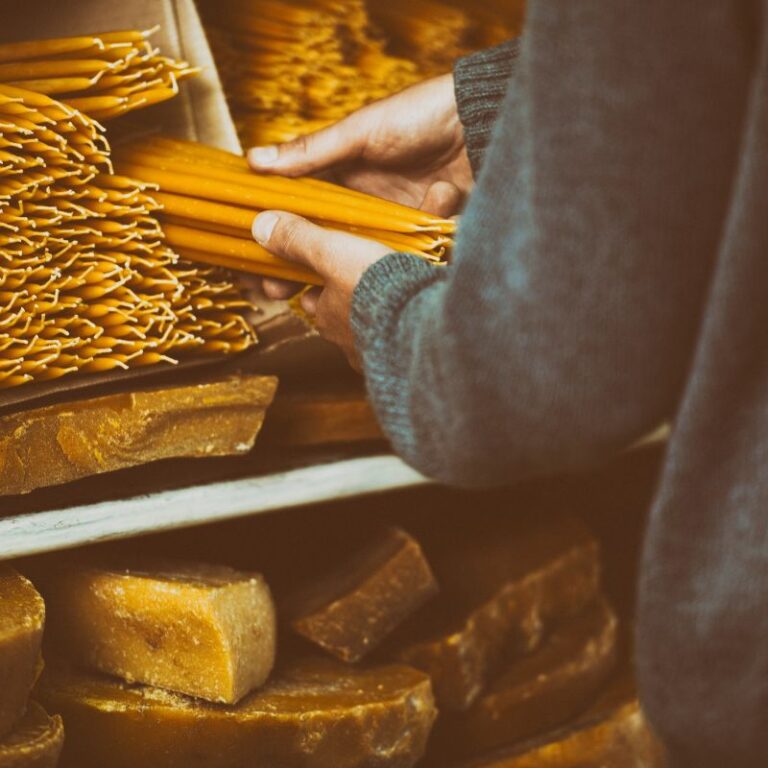
Beeswax Is A Renewable Resource
It takes honeybees 8.4 pounds of honey to produce 1 pound of beeswax. The bees do not make beeswax out of honey, but they need to consume honey to produce wax from the special glands in their abdomens. The honey gives them the energy they need to do that work.
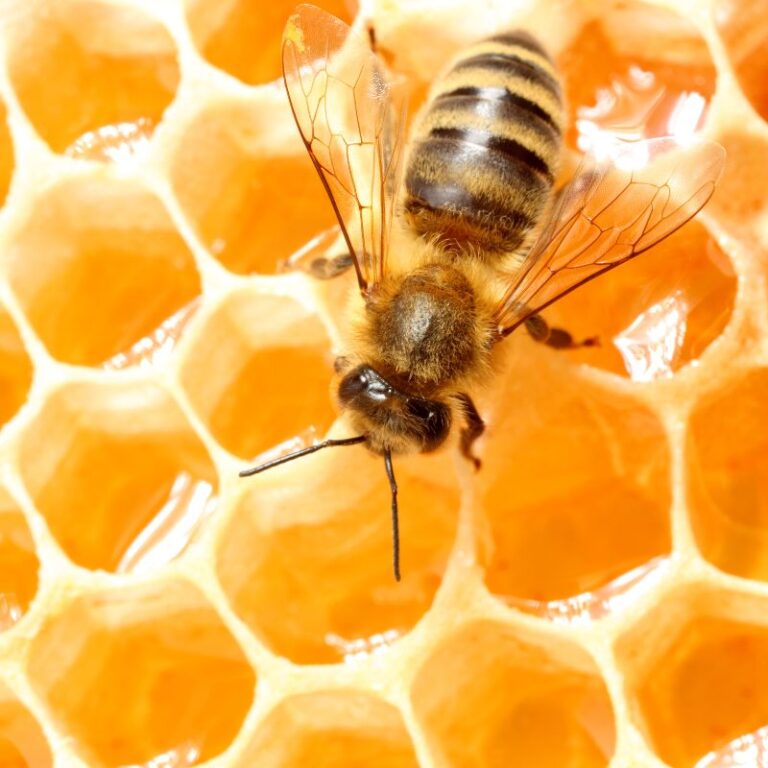
Consider this: a single bee produces 1/12 teaspoon of honey in her lifetime. To produce 8 pounds (almost 11 cups) of honey, bees need to collect and reduce 32 pounds (2.6 gallons) of nectar, which they collect from 64 million flowers! It takes a lot of busy bees to make beeswax! (These fascinating facts came from the book The Beekeeper’s Handbook.)
As you can imagine, beeswax is very dear to the honeybees and the beekeeper—in fact, beeswax costs more than honey—but one of the reasons that people have honeybees is because they almost always produce extra honeycomb.
As long as people keep bees, there will be wax to process, and these handcrafted natural candles will be a product to be enjoyed.
History of Beeswax Candles
According to the book Beeswax Alchemy by Petra Ahnert, Beeswax candles were used by many ancient cultures: Egyptian, Greek, Roman, and Chinese. They have always been used in European churches—in fact, many churches still require at least 51% beeswax in their candles. This is why many monasteries and abbeys still maintain apiaries. In Catholicism, the beeswax symbolizes Christ’s flesh; the wick, his soul; and the flame, his divinity.
As long as people have searched for spiritual meaning, honeybees and their products have been used to honor those beliefs. Egyptians believed that bees were born from the tears of the Sun God, Ra. When Rashed tears, his tears became honeybees, which led to beeswax being a sacred substance. Many other religions and belief systems regularly use beeswax in ceremonies and rituals. At her historical funeral, giant beeswax candles were burned in memory of Queen Elizabeth II.
Here’s a link to an interesting article that lists other sacred beliefs about beeswax: The Romance of Beeswax Candles
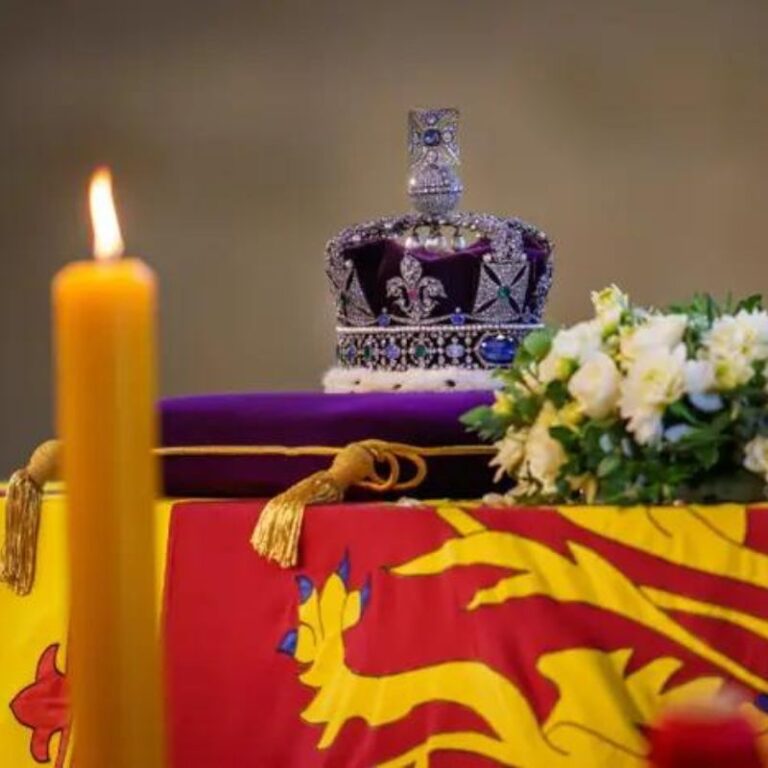
Modern Candle Making
Beeswax candle making hasn’t changed much from its beginning. Originally candles were dipped, which means a wick was dipped into melted wax repeatedly until the wax built up enough to fuel a fire. What burns in a candle is the wax vapor, produced by the flame’s heat. In the nineteenth century, candle molds were invented, and today silicone candle molds are very popular and easy to use. Hot, melted beeswax is poured into a mold with a wick in place and then allowed to cool completely before removal.
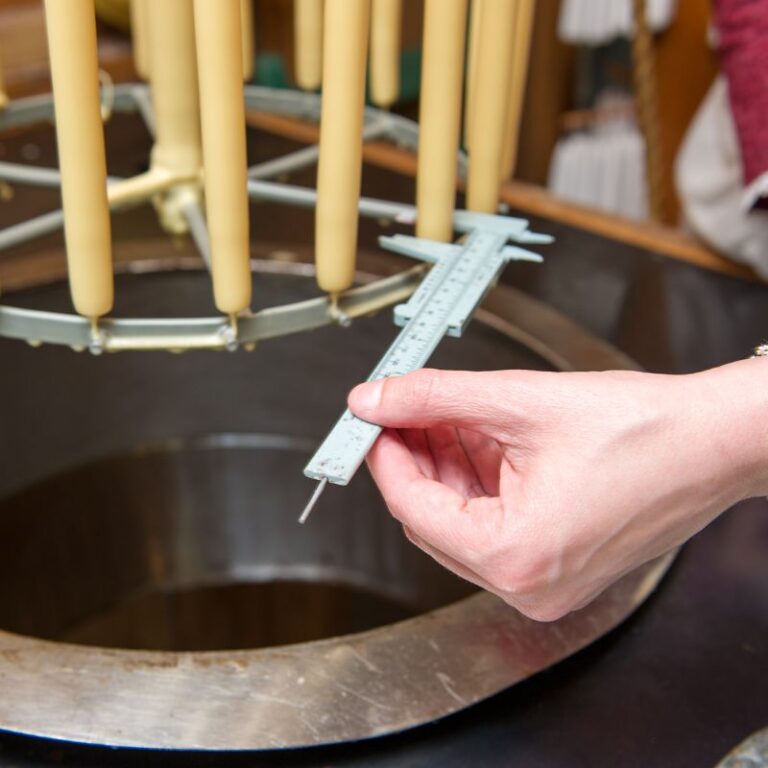
Most paraffin candles you see nowadays are not melted and poured into molds or dipped. They are typically pressed into molds on machines using pressure. In contrast, beeswax candles are still mostly handcrafted, made by people who love bees and consider what they do an art. Steeped in this tradition, modern beeswax candles are rich with custom, function, and beauty.
How candles are pressed into molds in a factory: Candle making pneumatic press for candles
How Beeswax Candles Are Made
Beeswax candles are made by melting wax, then encasing a cotton wick inside the wax, which hardens until someone lights a flame to burn the wick.
Dipping is the oldest method and how we make our taper candles. Wicks are extended in some way, then repeatedly dipped. Each time they are dipped, another coat of wax is added to the wick until it is thick enough to stand on its own and be lighted.
Candles can also be poured. To pour a candle, first, the wax is melted, and then it is poured (at just the right temperature) into a mold with a wick placed inside. Molds can be many different shapes and sizes, and the wick size has to be adjusted so that the candle will burn efficiently.
When the wax completely cools, the candle is removed from the mold, and the mold can be used again.
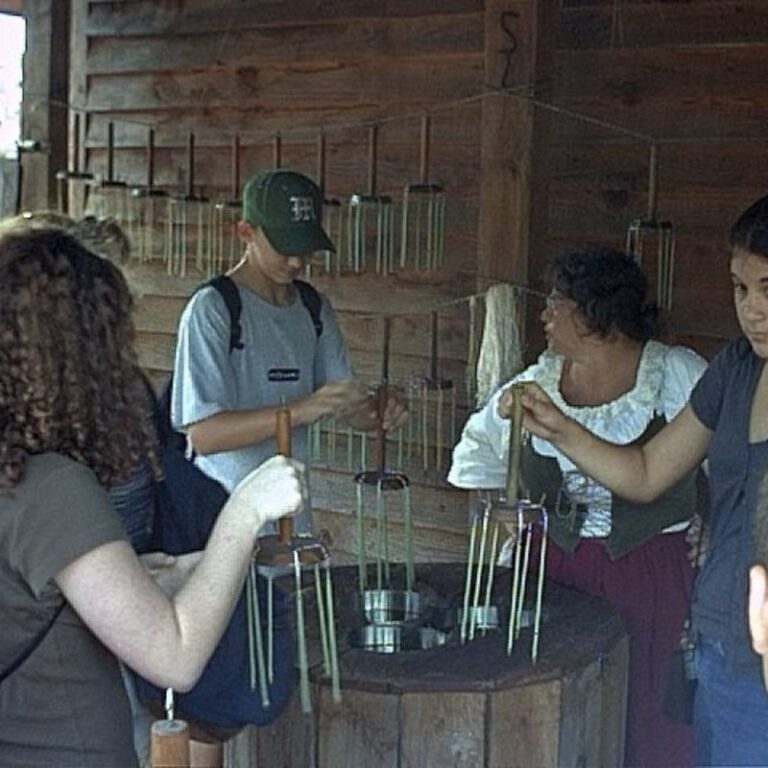
Making Your Own Beeswax Candles
Beeswax candles make very nice gifts, and you can enjoy making them yourself. You’ll need a way to melt the wax, some correctly-sized wicks, silicone molds, or a way to dip the wicks if you want to make hand-dipped tapers, and most importantly, beeswax. You can get pure yellow beeswax with a lovely natural scent from Foxhound Bee Company in 1 oz, 16 oz, and 20 lb blocks.
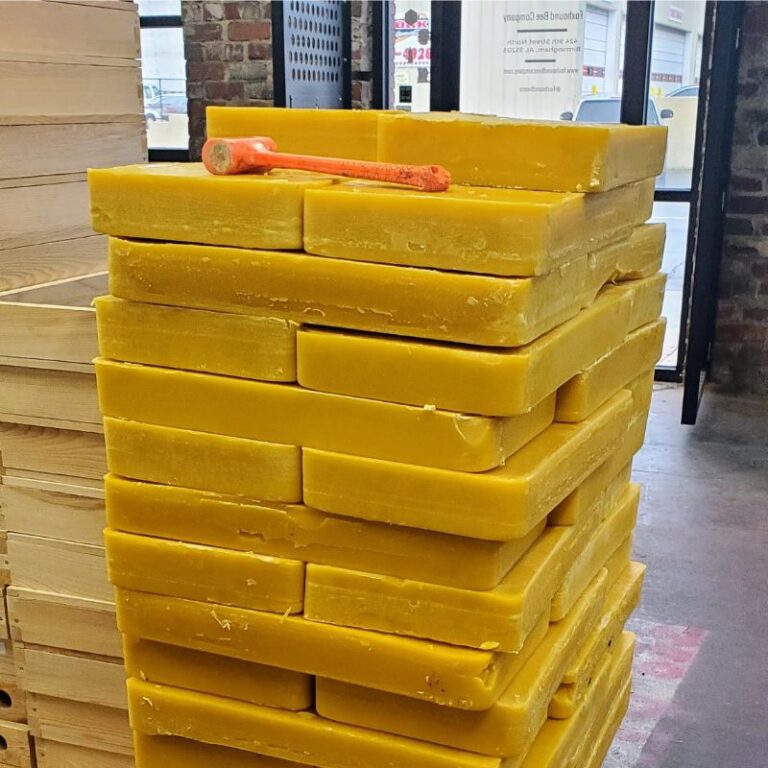
Tea lights or votives are quick to pour and cool, and they don’t take much wax to make. There are many styles and varieties of candle molds available. You will find molds of skulls, Christmas trees, and almost anything else you can imagine. You’ll want to make sure you have enough wax to fill the mold. Better to have too much than not enough! You can always use it later if you have some leftover.
The ideal temperature to pour beeswax is between 160-165 degrees F. An infrared thermometer is really useful for checking temperature without making a mess. Do your research to make sure you have the right-sized wick, and the wick should be 100% cotton. You can add scents or dyes, if you like, but beeswax smells and looks wonderful all on its own.
Dipping candles is another method that makes beautiful taper candles, and for this, you’ll need special equipment.
What Happens When You Burn a Beeswax Candle
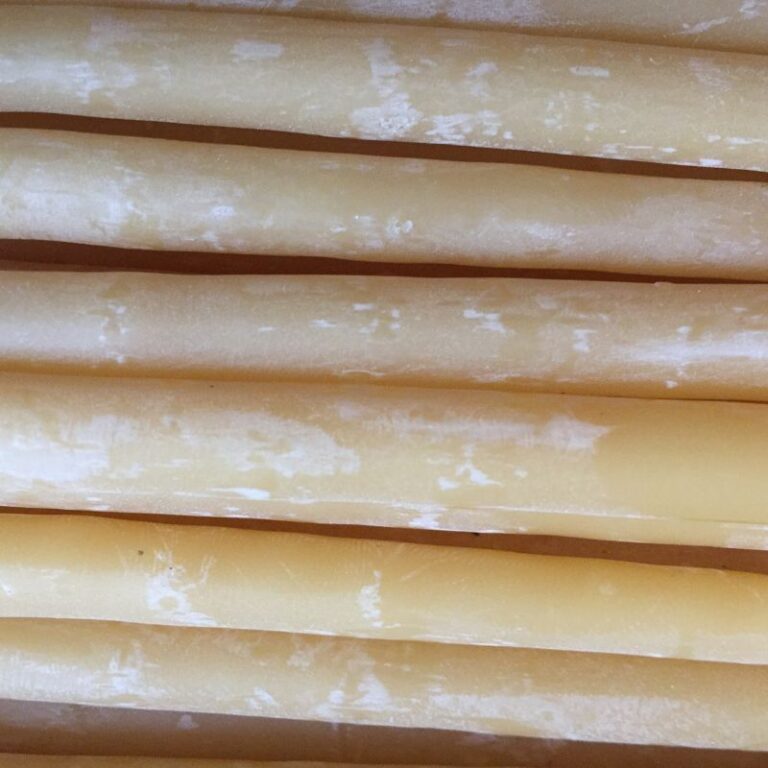
Light a beeswax candle. It burns quietly with minimal dripping, and it has a brighter flame because of its high melting point. What burns is the vapor that is produced by the heat of the flame on the wick. Beeswax candles have a slow burn because of their heavy density, and rather than creating indoor air pollution, they may increase air quality.
Over time you might notice a white film on your beeswax candle. This is called bloom and can be remedied with a little heat or by rubbing the candle with a cloth. Bloom is a natural process and does not have to be addressed unless it bothers you.
Beeswax candles burn longer and drip less or are dripless. Have you ever had a paraffin or soy candle just turn into a puddle of solid wax? It’s a mess to clean up, and the candle is obliterated. This catastrophe won’t happen with a beeswax candle. While the beeswax candle may be more expensive up front, it will last longer without dripping and save you money in the long run.
Popular Types of Beeswax Candles
For every candle user, there is a perfect type of beeswax candle. Classic Tapers burn for about an hour per inch and even more for the longer ones. Thin Tapers are less expensive and burn for a shorter time, but their thin stalks are striking, and several of them could make a beautiful centerpiece. There are even thinner beeswax candles that are the diameter of a pencil which are great for prayer or meditation. To burn a taper candle, you’ll need a taper candle holder. These candles are unable to stand up on their own.
Tea Lights and Votives are smaller, but they will burn for a surprisingly long time. Tea lights and votives are most safely burned inside Votive or Tealight Candleholders.
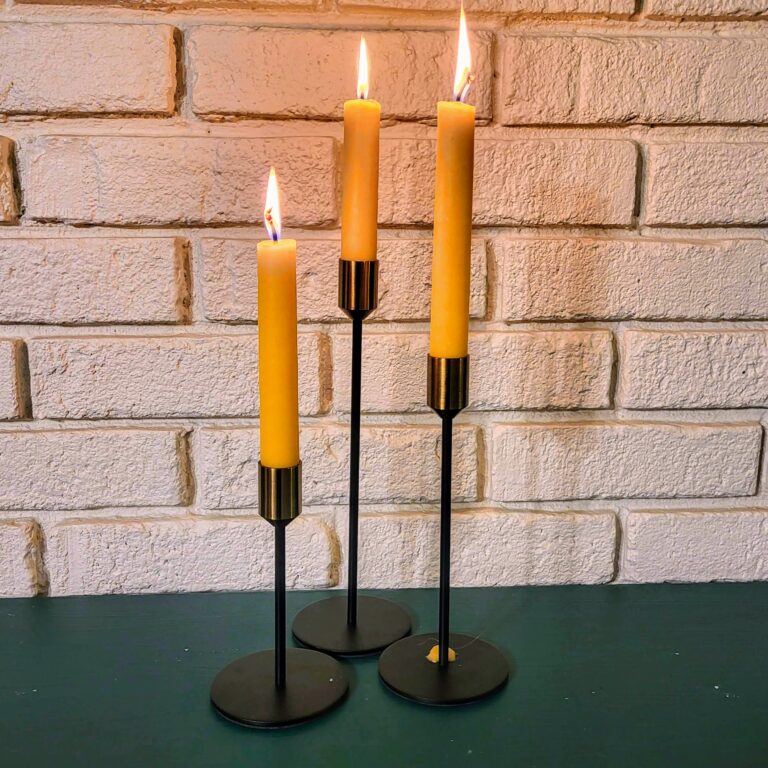
For a candle that will look simply classical and last a very long time, a great choice is the 3-inch Pillar Candle. Pillar Candles will burn from 45 hours for a three-inch tall pillar to 130 hours for a nine-inch candle. Pillar Candles can stand on their own but look very attractive on a candle plate or pedestal.
Container candles come in many different styles and shapes. Our Recycled (Can)dle can be custom-poured into your favorite beverage can. You can even buy a six-pack! If you like a glass container, we also make Seven Day Prayer Candles, which will burn for 100 hours. These candles won’t need any kind of stand, as they came in their own package.
Beeswax candles often come in decorative shapes. The ones we carry, Honey Comb Beeswax Candles and the smaller-sized Antique Window Beeswax Candle, are basically pillars but with a decorative exterior pattern. These will need a stand or container of some sort to burn safely.
Comparing Beeswax Candles
Beeswax vs. Paraffin candles
Paraffin candles are the most common and inexpensive type of candles. Paraffin is a non-renewable by-product of petroleum. Paraffin candles were first invented in 1830 as a replacement for tallow candles, which were made of a rendered form of beef or mutton.
Paraffin candles burned more cleanly and more reliably than tallow candles. Most people at that time used oil lamps, and candles were for special occasions.
Paraffin requires additives such as stearic acid (from animal fat) to make candles that drip less and to increase burn time. (They still drip more and burn more quickly than beeswax candles) Paraffin candles are often scented, and they produce more soot than other types of candles.
While you may think you can save money buying cheap candles, you’ll find that the benefits of beeswax candles outweigh the price advantage.

Paraffin candles will usually be coated with a color, or the wax will have dyes. Natural beeswax comes in shades of yellow, gold, and brown. If you see white beeswax, it has been ultra-filtered and possibly bleached to make it white. If you want pure beeswax candles, look for the 100% pure beeswax label on a lovely yellow candle.
Here’s a YouTube video of a flame test between paraffin, soy, and beeswax candles: Beeswax vs. Soy Wax vs. Paraffin wax!: Place yer Bets! (Spoiler alert: The Beeswax candle lasts significantly longer than the Paraffin or Soy candles.)
Beeswax vs. Soy Candles
Soy candles are all natural—soy wax is a by-product of the soybean industry. Soy wax is more expensive than paraffin but cheaper than beeswax. Soy wax can go rancid—it will spoil without added preservatives. Often extra fragrances are added to mask the scent of spoiled wax. Beeswax candles will not spoil like this.
Soy candles burn slower than paraffin, and they produce some black soot. Because they can spoil, candlemakers will often mix in additives and hardeners. Some candlemakers will add beeswax to their soy wax to raise the melting point. Soy wax is popular, but beeswax candles require no chemical processing and burn longer than soy, and high-quality candles made of beeswax candles don’t ever go rancid.
Beeswax vs Coconut Wax
Coconut wax is extremely soft. It is a hardened form of coconut oil. It can melt at room temperature, meaning it needs to be blended with other waxes. Some candlemakers blend beeswax with their coconut wax to raise the melting point. It is made from the meat of a coconut and reportedly produces little soot. Coconut wax is mainly used for container candles because of its softness. It is considered environmentally friendly because coconuts are a renewable resource.
Like beeswax, it is biodegradable and compostable, but beeswax can be produced locally almost everywhere in the world, while coconuts can only be grown in very rainy places. The financial and environmental costs of shipping make beeswax a more attractive option.
Beeswax Candles Help Honeybees and Beekeepers
When beekeepers harvest honey from their hives, they harvest wax as a natural by-product. Most beekeepers save their wax and melt it down to use in various ways, or they’ll sell it. Beekeepers use a variety of methods to melt and filter their beeswax. Read this Foxhound blog about Cleaning, Rendering, and Filtering Beeswax.
Beeswax candles cost more, but when you buy a beeswax candle, you support the craftsperson who hand-crafted it, the beekeeper who collected, cleaned, and rendered the wax, and ultimately, the honeybees who produced the wax. The natural beeswax candle may cost more, but it will burn longer, be cleaner, dripless, and smell naturally amazing. If you love bees, you’ll love beeswax candles.
Warnings for Burning Beeswax Candles
Candles are small fires. Be mindful of the dangers of lighting a fire inside your home or anywhere else. Here are some reminders:
Read labels. Only buy 100% beeswax candles with cotton wicks.
After you read the label, be sure to remove it.
Never leave any candle unattended.
Keep candles away from flammable objects.
Keep candles away from children and pets.
Keep the candle top free of debris such as matches or wick trimmings.
Place the candle on a level, non-flammable surface.
Stop burning the candle when it is almost to the bottom of the wick. (You can recycle leftover wax to make another candle.)



